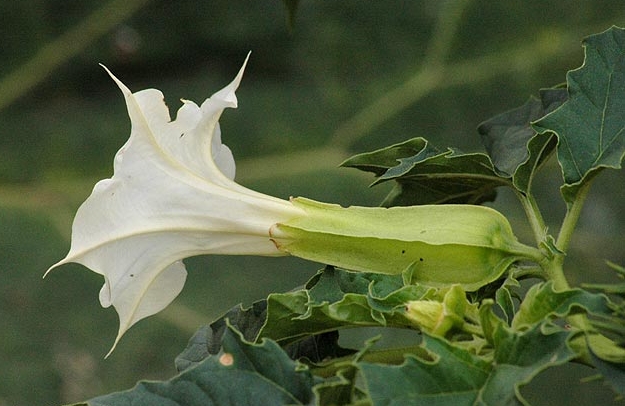
Common Names: Angel's Trumpet, Apple Of Peru, Buenas Tardes, Chamico, Chamisco, Cocombre Zombie, Cojon De Diablo, Concombre Zombie, Cornicopio, Daturah, Doornappelkruid, Estramoni, Estramonio, Feng Ch'Ieh Erh, Figuiero Do Inferno, Floribunda, Galurt, Gemeiner Stechapfel, Jamestown Weed, Jimson, Jimson Weed, Jimsonweed, Man T'O Lo, Nafeer, Noce Del Diavolo, Nongue, Opium Tropical, Pomme Epineuse, Pomme Poison, Stinkblaren, Stinkweed, Stramoine, Stramonium, Tapate, Thorn Apple, Thorn-Apple, Thornapple Habitat: Dry waste ground and amongst rubble or the ruins of old buildings. It is found in most of the continental US from New England to Texas, Florida to the far western states.
Magickal Uses:
Edible Uses: None known.
Medicinal Uses: Anodyne; Anthelmintic; Antiasthmatic; Antidandruff; Antiinflammatory; Antispasmodic; Hallucinogenic; Hypnotic; Mydriatic; Narcotic. The thornapple is a bitter narcotic plant that relieves pain and encourages healing. It has a long history of use as a herbal medicine, though it is very poisonous and should be used with extreme caution. The leaves, flowering tops and seeds are anodyne, antiasthmatic, antispasmodic, hallucinogenic, hypnotic, mydriatic and narcotic. The seeds are the most active medicinally. The plant is used internally in the treatment of asthma and Parkinson's disease, excess causes giddiness, dry mouth, hallucinations and coma. Externally, it is used as a poultice or wash in the treatment of fistulas, abcesses, wounds and severe neuralgia. The use of this plant is subject to legal restrictions in some countries. It should be used with extreme caution and only under the supervision of a qualified practitioner since all parts of the plant are very poisonous and the difference between a medicinal dose and a toxic dose is very small. . The leaves should be harvested when the plant is in full flower, they are then dried for later use. The leaves can be used as a very powerful mind-altering drug, they contain hyoscyamine and atropine. There are also traces of scopolamine, a potent cholinergic-blocking halucinogen, which has been used to calm schizoid patients. Atropine dilates the pupils and is used in eye surgery. The leaves have been smoked as an antispasmodic in the treatment for asthma, though this practice is extremely dangerous. The seeds are used in Tibetan medicine, they are said to have a bitter and acrid taste with a cooling and very poisonous potency. Analgesic, anthelmintic and antiinflammatory, they are used in the treatment of stomach and intestinal pain due to worm infestation, toothache and fever from inflammations. The juice of the fruit is applied to the scalp to treat dandruff.
Cultivation: Succeeds in most moderately good soils but prefers a rich light sandy soil or a calcareous loam, and an open sunny position. Plants often self-sow when well sited. The thornapple is cultivated commercially as a medicinal plant. It can become a weed in suitable conditions and is subject to statutory control in some countries. This species is extremely susceptible to the various viruses that afflict the potato family (Solanaceae), it can act as a centre of infection so should not be grown near potatoes or tomatoes. Grows well with pumpkins. The whole plant gives off a nauseating stench.
Propagation: Sow the seed in individual pots in early spring in a greenhouse. Put 3 or 4 seeds in each pot and thin if necessary to the best plant. The seed usually germinates in 3 - 6 weeks at 15°c. Plant out in late spring or early summer, after the last expected frosts. Especially in areas with hot summers, it is worthwhile trying a sowing outdoors in situ in mid to late spring.
Magickal Uses:
Edible Uses: None known.
Medicinal Uses: Anodyne; Anthelmintic; Antiasthmatic; Antidandruff; Antiinflammatory; Antispasmodic; Hallucinogenic; Hypnotic; Mydriatic; Narcotic. The thornapple is a bitter narcotic plant that relieves pain and encourages healing. It has a long history of use as a herbal medicine, though it is very poisonous and should be used with extreme caution. The leaves, flowering tops and seeds are anodyne, antiasthmatic, antispasmodic, hallucinogenic, hypnotic, mydriatic and narcotic. The seeds are the most active medicinally. The plant is used internally in the treatment of asthma and Parkinson's disease, excess causes giddiness, dry mouth, hallucinations and coma. Externally, it is used as a poultice or wash in the treatment of fistulas, abcesses, wounds and severe neuralgia. The use of this plant is subject to legal restrictions in some countries. It should be used with extreme caution and only under the supervision of a qualified practitioner since all parts of the plant are very poisonous and the difference between a medicinal dose and a toxic dose is very small. . The leaves should be harvested when the plant is in full flower, they are then dried for later use. The leaves can be used as a very powerful mind-altering drug, they contain hyoscyamine and atropine. There are also traces of scopolamine, a potent cholinergic-blocking halucinogen, which has been used to calm schizoid patients. Atropine dilates the pupils and is used in eye surgery. The leaves have been smoked as an antispasmodic in the treatment for asthma, though this practice is extremely dangerous. The seeds are used in Tibetan medicine, they are said to have a bitter and acrid taste with a cooling and very poisonous potency. Analgesic, anthelmintic and antiinflammatory, they are used in the treatment of stomach and intestinal pain due to worm infestation, toothache and fever from inflammations. The juice of the fruit is applied to the scalp to treat dandruff.
Cultivation: Succeeds in most moderately good soils but prefers a rich light sandy soil or a calcareous loam, and an open sunny position. Plants often self-sow when well sited. The thornapple is cultivated commercially as a medicinal plant. It can become a weed in suitable conditions and is subject to statutory control in some countries. This species is extremely susceptible to the various viruses that afflict the potato family (Solanaceae), it can act as a centre of infection so should not be grown near potatoes or tomatoes. Grows well with pumpkins. The whole plant gives off a nauseating stench.
Propagation: Sow the seed in individual pots in early spring in a greenhouse. Put 3 or 4 seeds in each pot and thin if necessary to the best plant. The seed usually germinates in 3 - 6 weeks at 15°c. Plant out in late spring or early summer, after the last expected frosts. Especially in areas with hot summers, it is worthwhile trying a sowing outdoors in situ in mid to late spring.
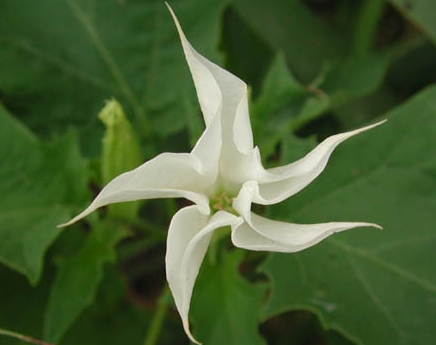
In Europe and iran thorn apple has been gathered for at
least 300 years. It is traditionally used in the
treatment of asthma, but is better known
for its mythical -and mystical- hallucinogenic
effects. It is for these qualities that it
is sued by Algonquin Indians as wysoccan
for adolescent rites. Caution: The whole
plant is very poisonous and is
particularly dangerous for children!Growing instructions
Sow early spring indoors. Pot up the
seedlings into individual pots as
soon as the first true leaf appears and
plant them out after the last expected frosts
least 300 years. It is traditionally used in the
treatment of asthma, but is better known
for its mythical -and mystical- hallucinogenic
effects. It is for these qualities that it
is sued by Algonquin Indians as wysoccan
for adolescent rites. Caution: The whole
plant is very poisonous and is
particularly dangerous for children!Growing instructions
Sow early spring indoors. Pot up the
seedlings into individual pots as
soon as the first true leaf appears and
plant them out after the last expected frosts
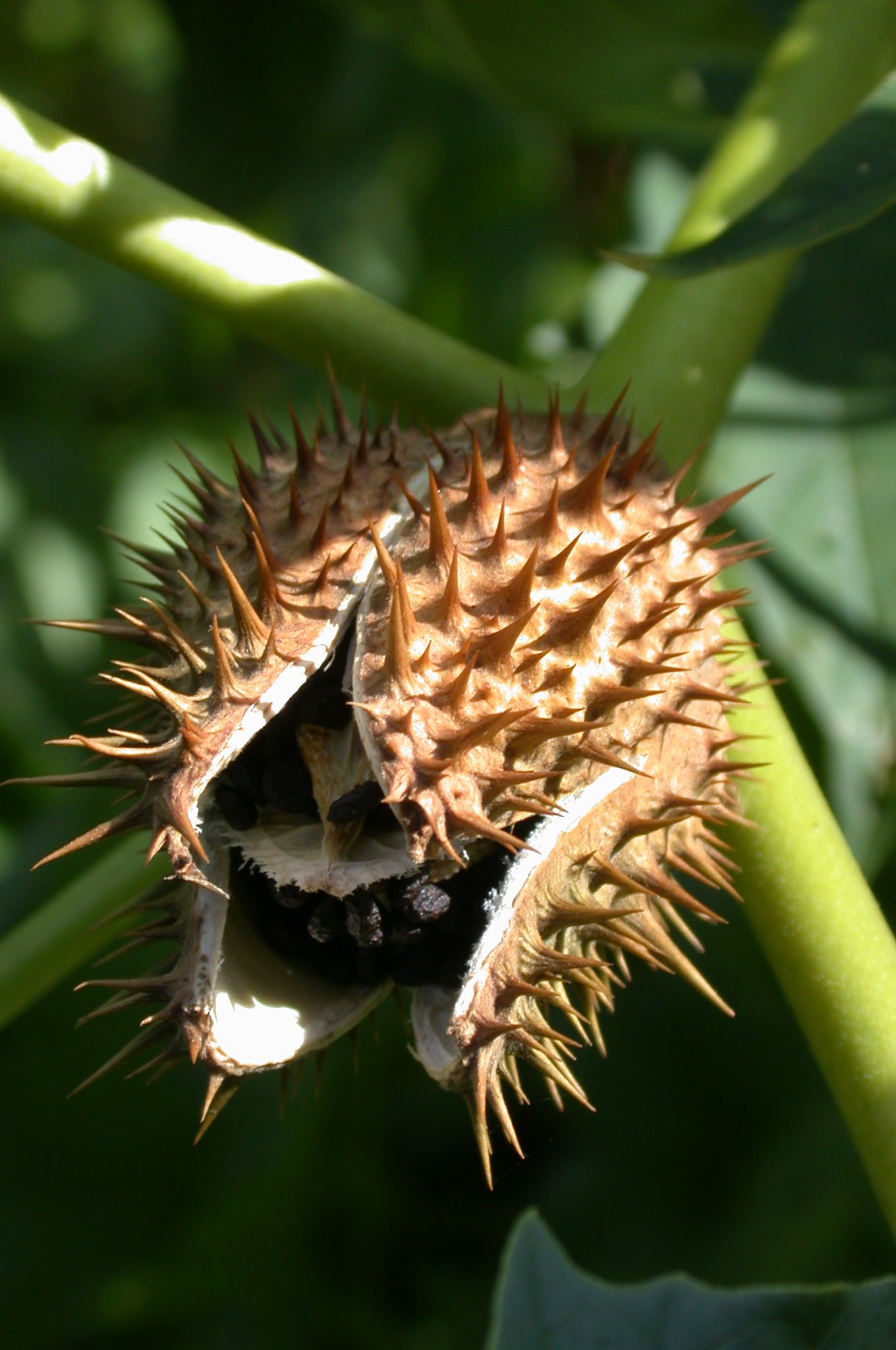 JIMSON WEED or thorn apple (Datura stramonium) is an illscented weedy annual with white to purplish flowers. Probably native to North America, it now grows in temperate and subtropical regions around the world. All parts of the plant, especially the brownish-black seeds, are toxic. This species is believed to have been the chief ingredient of wysoccon, used by the Algonquin Indians of eastern North America before the ritual of initiation into manhood
JIMSON WEED or thorn apple (Datura stramonium) is an illscented weedy annual with white to purplish flowers. Probably native to North America, it now grows in temperate and subtropical regions around the world. All parts of the plant, especially the brownish-black seeds, are toxic. This species is believed to have been the chief ingredient of wysoccon, used by the Algonquin Indians of eastern North America before the ritual of initiation into manhoodMedicinal Action and Uses---Antispasmodic, anodyne and narcotic. Its properties are virtually those of hyoscyamine. It acts similarly to belladonna, though without constipating, and is used for purposes similar to those for which belladonna is employed, dilating the pupil of the eyes in like manner. It is considered slightly more sedative to the central nervous system than is belladonna.
Stramonium is, in fact, so similar to belladonna in the symptoms produced by it in small or large doses, in its toxicity and its general physiological and therapeutic action, that the two drugs are practically identical, and since they are about the same strength in activity, the preparations may be used in similar doses.
Stramonium has been employed in all the conditions for which belladonna is more commonly used, but acts much more strongly on the respiratory organs, and has acquired special repute as one of the chief remedies for spasmodic asthma, being used far more as the principal ingredient in asthma powders and cigarettes than internally. The practice of smoking D. ferox for asthma was introduced into Great Britain from the East Indies by a certain General, and afterwards the English species was substituted for that employed in Hindustan. Formerly the roots were much used: in Ceylon, the leaves, stem and fruit are all cut up together to make burning powders for asthma, but in this country the dried leaves are almost exclusively employed for this purpose. The beneficial effect is considered due to the presence of atropine, which paralyses the endings of the pulmonary branches, thus relieving the bronchial spasm. It has been proved that the smoke from a Stramonium cigarette, containing 0.25 grams of Stramonium, leaves contains as much as 0.5 milligrams of atropine. The leaves may be made up into cigarettes or smoked in a pipe, either alone, or with a mixture of tobacco, or with cubebs, sage, belladonna and other drugs. More commonly, however, the coarsely-ground leaves are mixed into cones with some aromatic and with equal parts of potassium nitrate, in order to inincrease combustion and are burned in a saucer, the smoke being inhaled into the lungs. Great relief is afforded, the effect being more immediate when the powdered leaves are burnt and the smoke inhaled than when smoked by the patient in the form of cigars or cigarettes, but like most drugs, after constant use, the relief is not so great and the treatment is only palliative, the causation of the attack not being affected. Accidents have also occasionally happened from the injudicious use of the plant in this manner.
Dryness of the throat and mouth are to be regarded as indications that too large a quantity is being taken.
The seeds, besides being employed to relieve asthma in the same manner as the leaves, being smoked with tobacco, are employed as a narcotic and anodyne, generally used in the form of an extract, prepared by boiling the seeds in water, or macerating them in alcohol. A tincture is sometimes preferred. The extract is given in pills to allay cough in spasmodic bronchial asthma, in whooping-cough and spasm of the bladder, and is considered a better cough-remedy than opium, but should only be used with extreme care, as in over-doses it is a strong narcotic poison.
Applied locally, in ointment, plasters or fomentation, Stramonium will palliate the pain of muscular rheumatism, neuralgia, and also pain due to haemorrhoids, fistula, abscesses and similar inflammation.--Preparations and Dosages---Powdered leaves, 1/10 to 5 grains. Fluid extract leaves, 1 to 3 drops. Fluid extract seeds, 1 to 2 drops. Tincture leaves, B.P. and U.S.P., 5 to 15 drops. Powdered extract, U.S.P., 1/5 grain. Solid extract, B.P., 1/4 to 1 grain. Ointment, U.S.P.
- Gerard declared that:
- 'the juice of Thornapple, boiled with hog's grease, cureth all inflammations whatsoever, all manner of burnings and scaldings, as well of fire, water, boiling lead, gunpowder, as that which comes by lightning and that in very short time, as myself have found in daily practice, to my great credit and profit.'
The introduction of Stramonium into medicine is due chiefly to the exertions of Baron Storch, in the latter half of the eighteenth century, who was also instrumental in re-introducing Henbane into modern medicine.
In a recent issue of an American medical journal, the opinion was expressed that Stramonium was a remedy for hydrophobia, the writer saying 'there is no drug so far proven that deserves as thorough and careful a trial in this dread disease as Stramonium.'
The poorer Turks are said to use Stramonium instead of opium, for smoking.
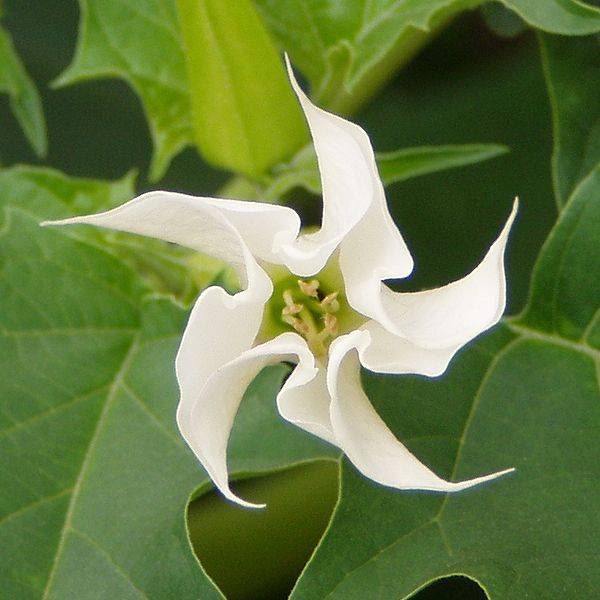
اسامی عمومی دیگر : Jimson Weed
نام علمی : Datura stramonium L.
نام خانواده :
نوع گیاه :
قسمت مورد استفاده : برگ و سر شاخه ها گلدار گياه است (همچنين دانه ها و ميوه هاي رسيده گياه)
خواص درمانی : تمام اين گياه مسكر مي باشد - مخدر قوي - بغايت منوم - رادع اورام حاره - تجفيف رطوبات غريبه - مسكن حرارت صداع صفراوي ودموي مزمن - تقويت اعضاي مسترخيه - جلوگيري از نزول نزلات بارده به عضوهايي مانند بيضه ها - تحليل ونضج اورام - : به علت وجود آلكالوئيد در گياه مصرف فراورده هاي غير استاندارد گياه توصيه نمي شود. اين گياه داراي آثار آنتي كليرژيك و پاراسمپاتولينيك مي باشد. فراكسيون اسكوپولامين بيشتر مسئول اين اثر هستند. مهمترين مواد متشكله گياه آلكالوئيدهاي تروپان ، لكتين ها ، روغن هاي چرب پروتئين ها مي باشند.
موارداستعمال در پزشکی سنتی : توجه داشته باشيد در بيماراني كه داراي احتباس ادرار يا اسكل از عروق كرونر نبايد مورد مصرف قرار گيرد. در بيماران داراي گلوكوم، ايلئوس پارالتيك، استنوزپيلوريك، پروستات بزرگ شده، آريتمي تاكيكاردي و ادم حاد ريوي منع مصرف دارد. - مصرف دارو به همراه ساير داروهاي آنتي كلينرژيك اثر تجمعي دارد. مصرف مقادير بالاي آن باعث تحريك سيستم عصبي مركزي كه به همراه آن exhaustion و خواب عارض مي شود. چهار علامت هشدار دهنده سميت در مورد گياه شامل سرخي پوست، خشكي دهان، آرتيمي تا كيكاردي و ميدرياز مي باشند. مشكلات ديگري كه شامل افزايش حرارت در اثر كاهش ترشح عرق، مشكلات micturtion و يبوست شديد كه عوارضي است كه ممكن است در اثر مصرف زياد بروز كنند.
مقدار و دستور مصرف : پودر برگ: 1/0-05/0 گرم تا 3 بار در روز يعني 6/0 گرم در روز و به عنوان ناركوتيك يك گرم در روز دانه گياه : 05/0 گرم دوز منفرد خوراكي، 6/0 گرم روزانه تنتور دانه: 3/0 گرم خوراكي دوز منفرد، 3 گرم دوز روزانه
نام علمی : Datura stramonium L.
نام خانواده :
نوع گیاه :
قسمت مورد استفاده : برگ و سر شاخه ها گلدار گياه است (همچنين دانه ها و ميوه هاي رسيده گياه)
خواص درمانی : تمام اين گياه مسكر مي باشد - مخدر قوي - بغايت منوم - رادع اورام حاره - تجفيف رطوبات غريبه - مسكن حرارت صداع صفراوي ودموي مزمن - تقويت اعضاي مسترخيه - جلوگيري از نزول نزلات بارده به عضوهايي مانند بيضه ها - تحليل ونضج اورام - : به علت وجود آلكالوئيد در گياه مصرف فراورده هاي غير استاندارد گياه توصيه نمي شود. اين گياه داراي آثار آنتي كليرژيك و پاراسمپاتولينيك مي باشد. فراكسيون اسكوپولامين بيشتر مسئول اين اثر هستند. مهمترين مواد متشكله گياه آلكالوئيدهاي تروپان ، لكتين ها ، روغن هاي چرب پروتئين ها مي باشند.
موارداستعمال در پزشکی سنتی : توجه داشته باشيد در بيماراني كه داراي احتباس ادرار يا اسكل از عروق كرونر نبايد مورد مصرف قرار گيرد. در بيماران داراي گلوكوم، ايلئوس پارالتيك، استنوزپيلوريك، پروستات بزرگ شده، آريتمي تاكيكاردي و ادم حاد ريوي منع مصرف دارد. - مصرف دارو به همراه ساير داروهاي آنتي كلينرژيك اثر تجمعي دارد. مصرف مقادير بالاي آن باعث تحريك سيستم عصبي مركزي كه به همراه آن exhaustion و خواب عارض مي شود. چهار علامت هشدار دهنده سميت در مورد گياه شامل سرخي پوست، خشكي دهان، آرتيمي تا كيكاردي و ميدرياز مي باشند. مشكلات ديگري كه شامل افزايش حرارت در اثر كاهش ترشح عرق، مشكلات micturtion و يبوست شديد كه عوارضي است كه ممكن است در اثر مصرف زياد بروز كنند.
مقدار و دستور مصرف : پودر برگ: 1/0-05/0 گرم تا 3 بار در روز يعني 6/0 گرم در روز و به عنوان ناركوتيك يك گرم در روز دانه گياه : 05/0 گرم دوز منفرد خوراكي، 6/0 گرم روزانه تنتور دانه: 3/0 گرم خوراكي دوز منفرد، 3 گرم دوز روزانه
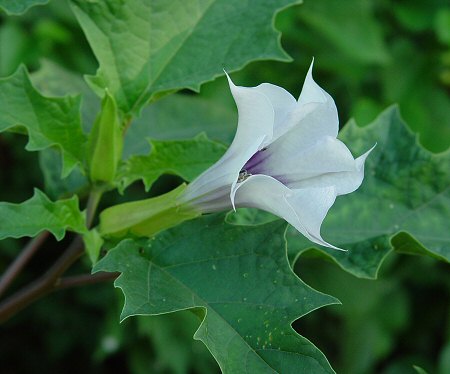
Description---The Thornapple is a large and coarse herb, though an annual, branching somewhat freely, giving a bushy look to the plant. It attains a height of about 3 feet, its spreading branches covering an area almost as broad. On rich soil it may attain a height of even 6 feet. The root is very long - thick and whitish, giving off many fibres. The stem is stout, erect and leafy, smooth, a pale yellowishgreen in colour, branching repeatedly in a forked manner, and producing in the forks of the branches a leaf and a single, erect flower. The leaves are large and angular, 4 to 6 inches long, uneven at the base, with a wavy and coarsely-toothed margin, and have the strong, branching veins very plainly developed. The upper surface is dark and greyish-green, generally smooth, the under surface paler, and when dry, minutely wrinkled.
The plant flowers nearly all the summer. The flowers are large and handsome, about 3 inches in length, growing singly on short stems springing from the axils of the leaves or at the forking of the branches. The calyx is long, tubular and somewhat swollen below, and very sharply five-angled, surmounted by five sharp teeth. The corolla, folded and only half-opened, is funnel-shaped, of a pure white, with six prominent ribs, which are extended into the same number of sharppointed segments. The flowers open in the evening for the attraction of night-flying moths, and emit a powerful fragrance.
The flowers are succeeded by large, eggshaped seed capsules of a green colour, about the size of a large walnut and covered with numerous sharp spines, hence the name of the plant. When ripe, this seed-vessel opens at the top, throwing back four valve-like forms, leaving a long, central structure upon which are numerous rough, dark-brown seeds. The appearance of the plant when in flower and fruit is so peculiar that it cannot be mistaken for any other native herb.
The plant is smooth, except for a slight downiness on the younger parts, which are covered with short, curved hairs, which fall off as growth proceeds. It exhales a rank, very heavy and somewhat nauseating narcotic odour. This foetid odour arises from the leaves, especially when they are bruised, but the flowers are sweet-scented, though producing stupor if their exhalations are breathed for any length of time.
The plant is strongly narcotic, but has a peculiar action on the human frame which renders it very valuable as a medicine. The whole plant is poisonous, but the seeds are the most active; neither drying nor boiling destroys the poisonous properties. The usual consequences of the poison when taken in sufficient quantity are dimness of sight, dilation of the pupil, giddiness and delirium, sometimes amounting to mania, but its action varies greatly on different persons. Many fatal instances of its dangerous effects are recorded: it is thought to act more powerfully on the brain than Belladonna and to produce greater delirium. The remedies to be administered in case of poisoning by Stramonium are the same as those described for Henbane poisoning, and also Belladonna poisoning. It is classed in Table II of the poison schedule. The pupils have become widely dilated even by accidentally rubbing the eyes with the fingers after pulling the fresh leaves of Stramonium from the plant.
The seeds have in several instances caused death, and accidents have sometimes occurred from swallowing an infusion of the herb in mistake for other preparations, such as senna tea.
Browsing animals as a rule refuse to eat Thornapple, being repelled by its disagreeable odour and nauseous taste, so that its presence is not really dangerous to any of our domestic cattle. Among human beings the greater number of accidents have occurred among children, who have eaten the halfripe seeds which have a sweetish taste.
The poisonous properties of the seeds are well known in India, where the Datura is abundant, the thieves and assassins not unfrequently administering them to their victims to produce insensibility.
In America it is called the 'Devil's Apple,' from its dangerous qualities and the remarkable effects that follow its administration. When the first settlers arrived in Virginia, some ate the leaves of this plant and experienced such strange and unpleasant effects that the colonists (so we are told) gave it this name by which it is still known in the United States. It is also known very commonly there by the name of 'Jamestown (or Jimson) Weed,' derived probably from its having been first observed in the neighbourhood of that old settlement in Virginia.
There are two varieties of this species of Datura, one with a green stem and white flowers, the other with a dark-reddish stem, minutely dotted with green and purplish flowers, striped with deep purple on the inside. The latter is now considered as a distinct species, being the D. Tatula of Linnaeus. The leaves are mostly of a deeper green, and have purplish foot-stalks and mid-ribs.
De Candolle considered D. Tatula to be a native of Central America, whence it was imported into Europe in the sixteenth century, and naturalized first in Italy and then in South-west Europe, where it is very common. It occurs in England more rarely than D. Stramonium, under similar conditions and seems a more tender plant. It is sometimes cultivated here. The properties of both species are the same.
In early times, the Thornapple was considered an aid to the incantation of witches, and during the time of the witch and wizard mania in England, it was unlucky for anyone to grow it in his garden
3 comments:
اول اینکه بابت بلاگ آموزندت ممنون
من دقیقا به تاریخ 11/11/90 صرفا جهت امتحان یه سایکدلیک جدید دوزی حول و حوش 1300-1400 دونه ی داتورا رو با آب میل نمودم، بعد از یکی دو ساعت به خیال اینکه این جنس عمرا ما رو نمی گیره به دوست عزیزم علف رو کردم و سه تاسیگاری (جای شما خالی) چوقیدم. تقرایبا نیم ساعت بعد از چوقیدن احساس کردم معده ام گر گرفته، شت داتورا هیت می، از اون لحظه تا 24 ساعت بعدش و خیلی کم یادم میاد، مثل آدمی که شب خواب دیده و فردا صبحش هیچی ازش یادش نمیاد ولی به جرات میتونم بگم قوی ترین سایکدلیکی که حقیر تا به امروز مصرف کرده همین داتوراس، خلاصه کلی آدمو شیطان و عدد و کلی چیزای دیگه دیدم که قویترین ماشروما هم یه سکانس از اونا رو برام تا حالا تداعی نکرده بودن، البته یه چنین دوزی اصولا پیشنهاد نمیشه، منم چون فکر می کردم یه چیزی تو مایه های ماشرومه زدم و بدون تحقیقات قبلی، ساید افکتاشم بعد از 24 ساعت تا حول وحوش یه هفته همرام بودن که شامل: شیزوفرنی (تا به حال تجربه اسکیتزو بودن نداشتم ولی بعد از اون هر وخ تنها می شدم یه سری آدم میومد سراقم و سر مارو به حرف میگرفت) عدم تطابق دید (عدم فوکوس روی آبجکتای نزدیک) احساس خنگی (این خییلی بده)، لکنت زبان، مموری گپ (این اسمیه که من روش گذاشتم، مثلا این ور خیابونی لحظه ی بعد اونورشی، من کی اومدم این ور، چی شد، تیک عصبی مخصوصا توی پام، یهو پام شوت می شد و به همین خاطر پله برام شده بود کابوس، و اینکه یه چیزه سیاهی همش دنبالم می کرد، به هر حال من تصمیم دارم که دوباره داتورا بزنم ولی مطمئانم به این زودیا نیس، البته یه دوز پایینتر که از تریپ داتورا یه چیزی یادم بمونه، و اینکه اصلا چیزه هپی نیس، پس برا تفریح طرفش نرین که فقط کابوسه
and one more question or request or whatever, did u ever tried dmt, ive searched almost every park but i couldnt find that specific acacia which needed to ... u know what im talkin about ;) if u ever had a trip on sacred dmt please contact me somehow, soon, cuz i think ure livin in tehran, and ill be here just for 3 or 4 more days, and its not safe to exchange numbers and emails over the internet, i dunno if ure paranoid like me or not, so if u wanted to check my identity check on my fb profile, its fb.com/tw1psy and send me ur phone number, i havent written all the things about datura, ive just write somethin to inform u "i am", so remove my babbling after u read it, since datura ive found out my soul is fuckin trapped, help me
online \m/
Post a Comment